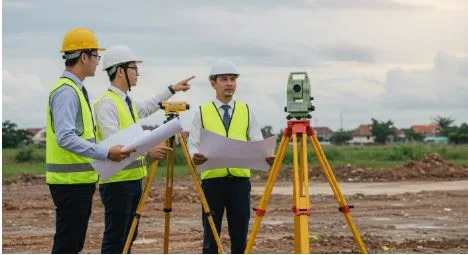How to Choose a Construction Site Location?
Among all other vital decisions, selecting a proper location for the construction of your building is very important. A perfect place is one that will give you functionality for a long time, save your money, keep your building safe, and also conform to the local safety regulations. To cut a long story short, a good place to build your project would be a step towards the success of your project.
Understanding Project Requirements
Nothing good comes without its goals. The first thing to be taken care of is setting up the objectives or goals. Comparing the needs of a residential building with those of an industrial warehouse or hospital will show the vast differences between them. Once we understand the need for a project, such as a very large land, access to a certain type of infrastructure, or even being under some health and safety standard will be the ones to set the location for the project, keeping a lot of other things aside. So, the implications of site conditions not being in harmony with the goals of a project may be exaggerated delays, increased costs, and degradation of even quality of work.
Most companies nowadays prefer Outsourcing Construction Estimatings when they are planning large-scale developments in order to be able to make a thorough comparison of the cost implications of different site options before they proceed with their final decision. This procedure helps avoid costly mistakes during budgeting processes, while also ensuring that every financial aspect of the site has been properly evaluated.
Evaluating Location Accessibility
The factor of accessibility is the most important one when it comes to choosing a location. Good places should facilitate the easy movement of materials, equipment, and labor. For instance, sites located near highways or railway connections are the ones that can help you get the best of your transportation in terms of costs and time. If it happens that your project is in the field of business, you, as an R&D man, must then understand that accessibility to customers has become the next thing in line in the list of the most vital things. In contrast, a location that is far away and has no road network may become a huge problem in terms of logistics.
Transportation Considerations
Easy and quick access for suppliers and subcontractors is one of the factors that help a project to be on time. Difficult access is usually associated with higher fuel costs and longer working hours.
Zoning And Land Use Regulations
A check on zoning regulations in the area is one of the first steps to be taken before the purchase of a site. Zones strictly designated for residential buildings will not allow industrial or commercial units, and vice versa. Constructing in a zone not allowed can also lead to very high penalties, along with the removal of the building. So, the examination of zoning maps and getting approval from the local government will be the assurance that the site selected is legally allowed for the project.
Environmental Considerations
The environmental aspect of a construction should not be overlooked. A location near the protected forest, swamp, or lake may require special environmental licenses. Besides, the existence of hazardous materials or the contamination of the soil can increase the cost of cleaning. Delaying the project due to legal limitations and protests of environmental enthusiasts can be less if one properly assesses the environmental factors right away.
Soil Testing And Geotechnical Conditions
The quality of the foundation depends on the strength of the underlying soil. Geotechnical investigations identify if the ground can safely carry the planned structure’s weight. Places with clay soils, high water tables, or areas where the soil is washed away might not be good, even with a hotpot of a few dollars of denim reinforcement. Earthquake-prone areas also have to undergo seismic assessments. Investing in soil testing at an early stage not only saves money but also eliminates safety risks over time.
Availability of Utilities and Infrastructure
Buildings of the new era have to be connected to the main networks that provide them with energy, water that is safe for drinking, sewers, and the internet with speed that is above average. If the place where you want to build your house does not have connections to utilities, there will be a need for a lot of money to be able to extend these services. It is also an issue of water that is being collected during a storm, which is a part of the waste management infrastructure and is important to meet the legal requirements and maintain sustainability.
Distance from the Workforce
The presence of both skilled and unskilled workers ready to take up the job within the shortest possible time at the location affects the working hours of the company positively. If the workers have to take long trips every day, productivity will go down, and labor costs will increase. In the case of city projects, the location of the labor force close to the residential areas will ensure that there will always be a labor force available. For industrial projects, we can say that the company bus service might be needed.
Cost of Land and Development
The price of land is the main factor that leads to site selection. Nevertheless, the cheapest alternative is not always the most advantageous one. The problem with a low-cost site is that it may have quite a few hidden expenses, such as tearing down the building’s existing structure on the site, difficulty in digging the ground, or very high permit fees. One must figure out the total development cost, along with the purchase price, before making a conclusion of the deal.
Table: Factors Influencing Land and Development Costs
| Factor | Impact on Cost | Example Scenario |
| Land Purchase Price | Direct | $200,000 for an urban plot |
| Site Preparation | Additional | Clearing trees, $15,000 |
| Utility Connections | High | Extending power lines, $30,000 |
| Legal Fees and Permits | Medium | $5,000–$10,000 |
| Environmental Remediation | Very High | Removing contaminated soil, $50,000+ |
Safety and Risk Assessment
Risk assessment is a form of protection for risk enablers as well as the environment. Long-term dangers are presented by locations in a flood or landslide area, for instance. On the other hand, the places with high fire risk can be subject to additional insurance and certain design. Besides, by evaluating local crime, we will be able to be sure about the safety of workers and equipment during work and in case of future occupants.
Market and Economic Factors
A project is directly influenced by the market surrounding it, which is the external market environment. The highest returns will be offered by commercial developments in areas with high economic growth and consumer demand. Sites for residential purposes that are located at a close distance to good schools, hospitals, and shopping centers become more attractive to buyers and renters. If a region is economically stable, then we can say that property value will increase with time.
Cultural and Community Impact
Construction work is not separated from society. One way to get rid of the social opposition that is the enemy of community acceptance. A project that interferes with local traditions, forcibly relocates residents, or generates an unending stream of whining and rattling as well as increased traffic, may be greeted with a throng of demonstrators. Maturing relationships with the community and ensuring that a project is a community asset are the two main factors for a smooth project execution.
Legal and Ownership Issues
Land disputes are among the leading causes of project interruptions. We have to ensure first that the title deed is correct, the owner is the one who has the right to the property, and there are no encumbrances on the property before we make a purchase. Legal due diligence is a preventative maintenance measure that helps avoid conflicts with government agencies, neighbors, or heirs in the future.
Environmental Sustainability Goals
Ecofriendliness is an important aspect that has been taken into consideration in designing the newly built modern buildings. Energy-efficient building orientation, rainwater harvesting, or simply renewable energy integration are some of the techniques utilized on-site to ensure long-term performance of buildings. Another reason for an eco-friendly site is the opportunity of obtaining a certificate such as LEED, which increases the salability of the building.
Future Expansion Possibilities
Generally, construction projects are getting expanded in phases. It is better to identify the flexible site first to avoid such situations as relocations that are costly. For example, there can be a need for an industrial facility to have more space for parking or warehouses in the future. The urban planners may look for the land where they can construct the tall buildings after getting the approval.
Comparing Multiple Locations
Most of the time, a project is not going to base its decision on only one location. To start with, the developers usually create a shortlist of sites they find most suitable and then proceed to compare these sites by using a weighted scoring system. In order to objectively identify the most acceptable location, these features, such as cost, accessibility, safety, and environmental impact, are given scores. Finally, site visits accompanied by very fruitful feasibility studies assist in making the choice.
Consulting with Professionals
The feedback of architects, engineers, environmental consultants, and legal advisors during the site evaluation can never be overemphasized. A professional feasibility study is a detailed breakdown of the technical and economic conditions. The involvement of specialists at the earliest stage ensures that the risks are kept to a minimum and informed decisions are made with confidence.
Final Decision-Making Process
Most of the time, the final location of a site would not be based on a single factor. Such a decision is a combination of costs, practicality, compatibility with the regulations, and plans. There is always openness when the results are presented in a well-organized report to the stakeholders. After they have reached an agreement, they will be able to sign the contracts and obtain the permits that will allow the construction to continue.
FAQs
- What is the most important factor in choosing a construction site?
Accessibility and regulatory compliance are often the most critical, as they directly impact costs and long-term use. - Why is soil testing necessary before buying land?
It determines if the ground can safely support the planned structure and avoids future structural failures. - How do zoning laws affect construction projects?
Zoning laws regulate what type of buildings can be constructed in specific areas, preventing legal conflicts. - Should I hire professionals for site evaluation?
Yes, consultants provide technical, legal, and financial insights that minimize risks in site selection. - Can outsourcing cost estimates help in site selection?
Yes, outsourcing cost estimations ensures accurate cost comparisons between different sites before making a decision.




